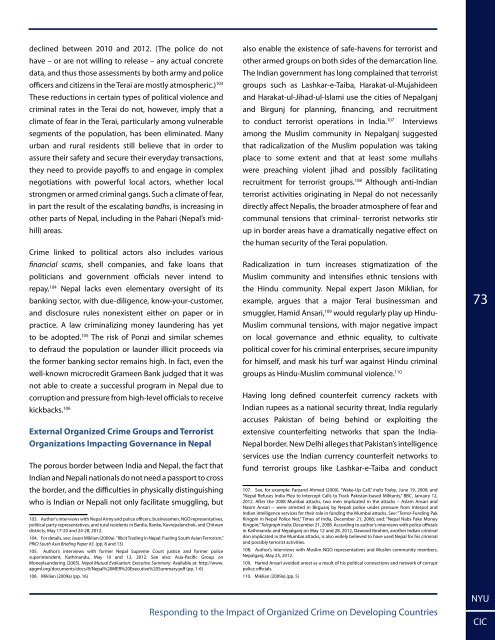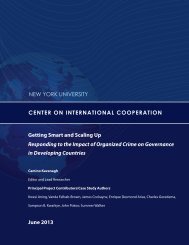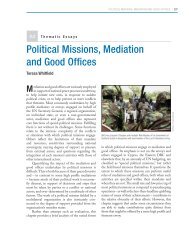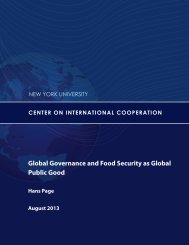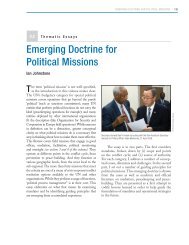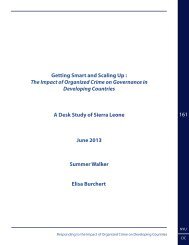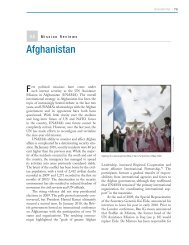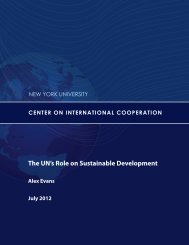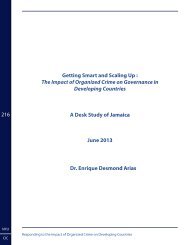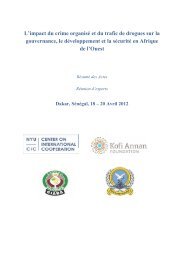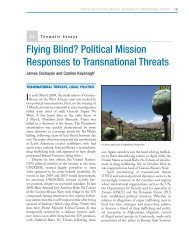here - Center on International Cooperation - New York University
here - Center on International Cooperation - New York University
here - Center on International Cooperation - New York University
You also want an ePaper? Increase the reach of your titles
YUMPU automatically turns print PDFs into web optimized ePapers that Google loves.
declined between 2010 and 2012. (The police do not<br />
have – or are not willing to release – any actual c<strong>on</strong>crete<br />
data, and thus those assessments by both army and police<br />
officers and citizens in the Terai are mostly atmospheric.) 103<br />
These reducti<strong>on</strong>s in certain types of political violence and<br />
criminal rates in the Terai do not, however, imply that a<br />
climate of fear in the Terai, particularly am<strong>on</strong>g vulnerable<br />
segments of the populati<strong>on</strong>, has been eliminated. Many<br />
urban and rural residents still believe that in order to<br />
assure their safety and secure their everyday transacti<strong>on</strong>s,<br />
they need to provide payoffs to and engage in complex<br />
negotiati<strong>on</strong>s with powerful local actors, whether local<br />
str<strong>on</strong>gmen or armed criminal gangs. Such a climate of fear,<br />
in part the result of the escalating bandhs, is increasing in<br />
other parts of Nepal, including in the Pahari (Nepal’s midhill)<br />
areas.<br />
Crime linked to political actors also includes various<br />
financial scams, shell companies, and fake loans that<br />
politicians and government officials never intend to<br />
repay. 104 Nepal lacks even elementary oversight of its<br />
banking sector, with due-diligence, know-your-customer,<br />
and disclosure rules n<strong>on</strong>existent either <strong>on</strong> paper or in<br />
practice. A law criminalizing m<strong>on</strong>ey laundering has yet<br />
to be adopted. 105 The risk of P<strong>on</strong>zi and similar schemes<br />
to defraud the populati<strong>on</strong> or launder illicit proceeds via<br />
the former banking sector remains high. In fact, even the<br />
well-known microcredit Grameen Bank judged that it was<br />
not able to create a successful program in Nepal due to<br />
corrupti<strong>on</strong> and pressure from high-level officials to receive<br />
kickbacks. 106<br />
External Organized Crime Groups and Terrorist<br />
Organizati<strong>on</strong>s Impacting Governance in Nepal<br />
The porous border between India and Nepal, the fact that<br />
Indian and Nepali nati<strong>on</strong>als do not need a passport to cross<br />
the border, and the difficulties in physically distinguishing<br />
who is Indian or Nepali not <strong>on</strong>ly facilitate smuggling, but<br />
103. Author’s interviews with Nepal Army and police officers, businessmen, NGO representatives,<br />
political party representatives, and rural residents in Bardia, Banke, Kavrepalanchok, and Chitwan<br />
districts, May 17-20 and 24-28, 2012.<br />
104. For details, see: Jas<strong>on</strong> Miklian (2009a). “Illicit Trading in Nepal: Fueling South Asian Terrorism,”<br />
PRIO South Asia Briefing Paper #3. (pp. 8 and 13)<br />
105. Author’s interviews with former Nepal Supreme Court justice and former police<br />
superintendent, Kathmandu, May 10 and 12, 2012. See also: Asia-Pacific Group <strong>on</strong><br />
M<strong>on</strong>eylaundering (2005). Nepal Mutual Evaluati<strong>on</strong>: Executive Summary. Available at: http://www.<br />
apgml.org/documents/docs/8/Nepal%20MER%20Executive%20Summary.pdf (pp. 1-6)<br />
106. Miklian (2009a) (pp. 16)<br />
also enable the existence of safe-havens for terrorist and<br />
other armed groups <strong>on</strong> both sides of the demarcati<strong>on</strong> line.<br />
The Indian government has l<strong>on</strong>g complained that terrorist<br />
groups such as Lashkar-e-Taiba, Harakat-ul-Mujahideen<br />
and Harakat-ul-Jihad-ul-Islami use the cities of Nepalganj<br />
and Birgunj for planning, financing, and recruitment<br />
to c<strong>on</strong>duct terrorist operati<strong>on</strong>s in India. 107 Interviews<br />
am<strong>on</strong>g the Muslim community in Nepalganj suggested<br />
that radicalizati<strong>on</strong> of the Muslim populati<strong>on</strong> was taking<br />
place to some extent and that at least some mullahs<br />
were preaching violent jihad and possibly facilitating<br />
recruitment for terrorist groups. 108 Although anti-Indian<br />
terrorist activities originating in Nepal do not necessarily<br />
directly affect Nepalis, the broader atmosp<str<strong>on</strong>g>here</str<strong>on</strong>g> of fear and<br />
communal tensi<strong>on</strong>s that criminal- terrorist networks stir<br />
up in border areas have a dramatically negative effect <strong>on</strong><br />
the human security of the Terai populati<strong>on</strong>.<br />
Radicalizati<strong>on</strong> in turn increases stigmatizati<strong>on</strong> of the<br />
Muslim community and intensifies ethnic tensi<strong>on</strong>s with<br />
the Hindu community. Nepal expert Jas<strong>on</strong> Miklian, for<br />
example, argues that a major Terai businessman and<br />
smuggler, Hamid Ansari, 109 would regularly play up Hindu-<br />
Muslim communal tensi<strong>on</strong>s, with major negative impact<br />
<strong>on</strong> local governance and ethnic equality, to cultivate<br />
political cover for his criminal enterprises, secure impunity<br />
for himself, and mask his turf war against Hindu criminal<br />
groups as Hindu-Muslim communal violence. 110<br />
Having l<strong>on</strong>g defined counterfeit currency rackets with<br />
Indian rupees as a nati<strong>on</strong>al security threat, India regularly<br />
accuses Pakistan of being behind or exploiting the<br />
extensive counterfeiting networks that span the India-<br />
Nepal border. <strong>New</strong> Delhi alleges that Pakistan’s intelligence<br />
services use the Indian currency counterfeit networks to<br />
fund terrorist groups like Lashkar-e-Taiba and c<strong>on</strong>duct<br />
107. See, for example: Farzand Ahmed (2000). “Wake-Up Call,” India Today, June 19, 2000; and<br />
“Nepal Refuses India Plea to Intercept Calls to Track Pakistan-based Militants,” BBC, January 12,<br />
2012. After the 2008 Mumbai attacks, two men implicated in the attacks – Aslam Ansari and<br />
Nasim Ansari -- were arrested in Birguanj by Nepali police under pressure from Interpol and<br />
Indian intelligence services for their role in funding the Mumbai attacks. See: “Terror-Funding Pak<br />
Kingpin in Nepal Police Net,” Times of India, December 21, 2008; and: “Nepal Nabs Fake M<strong>on</strong>ey<br />
Kingpin,” Telegraph India, December 21, 2008. According to author’s interviews with police officials<br />
in Kathmandu and Nepalganj <strong>on</strong> May 12 and 28, 2012, Dawood Ibrahim, another Indian criminal<br />
d<strong>on</strong> implicated in the Mumbai attacks, is also widely believed to have used Nepal for his criminal<br />
and possibly terrorist activities.<br />
108. Author’s interviews with Muslim NGO representatives and Muslim community members,<br />
Nepalganj, May 25, 2012.<br />
109. Hamid Ansari avoided arrest as a result of his political c<strong>on</strong>necti<strong>on</strong>s and network of corrupt<br />
police officials.<br />
110. Miklian (2009a).(pp. 5)<br />
73<br />
Resp<strong>on</strong>ding to the Impact of Organized Crime <strong>on</strong> Developing Countries<br />
NYU<br />
CIC


